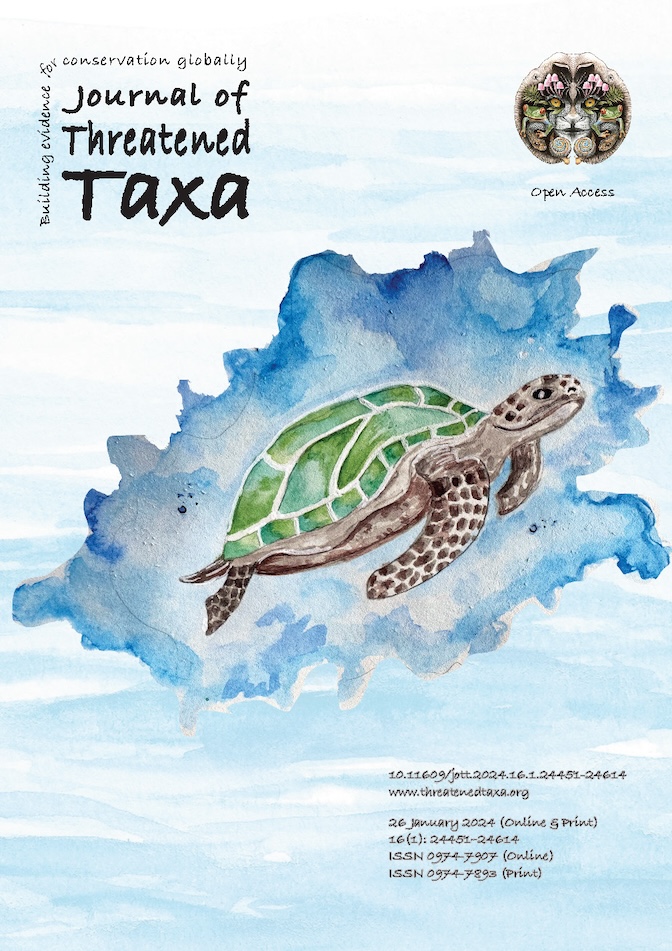Twice blooming flowers of Antigonon leptopus Hook. & Arn. (Magnoliopsida: Caryophyllales: Polygonaceae), a key forage source for insects during wet season in habitats disturbed by humans
Main Article Content
Abstract
Antigonon leptopus is an elegant weedy species that thrives well during wet season in habitats disturbed by humans; it shows vegetative and reproductive events in this season. Its flowers bloom twice with pollen and nectar presentation on day 1 and nectar presentation on day 2 for use by insects that act as pollinators. The flowers are unspecialized with exposed sex organs and presenting pollen and nectar which are easily accessible by the probing insects while collecting the floral rewards and effect pollination. The field study indicates that it acts as a key forage source for insects.
Article Details

This work is licensed under a Creative Commons Attribution 4.0 International License.
Authors own the copyright to the articles published in JoTT. This is indicated explicitly in each publication. The authors grant permission to the publisher Wildlife Information Liaison Development (WILD) Society to publish the article in the Journal of Threatened Taxa. The authors recognize WILD as the original publisher, and to sell hard copies of the Journal and article to any buyer. JoTT is registered under the Creative Commons Attribution 4.0 International License (CC BY), which allows authors to retain copyright ownership. Under this license the authors allow anyone to download, cite, use the data, modify, reprint, copy and distribute provided the authors and source of publication are credited through appropriate citations (e.g., Son et al. (2016). Bats (Mammalia: Chiroptera) of the southeastern Truong Son Mountains, Quang Ngai Province, Vietnam. Journal of Threatened Taxa 8(7): 8953–8969. https://doi.org/10.11609/jott.2785.8.7.8953-8969). Users of the data do not require specific permission from the authors or the publisher.
References
Armbruster, W.S., S.A. Corbet, A.J.M. Vey, S. Liu & S. Huang (2014). In the right place at the right time: Parnassia resolves the herkogamy dilemma by accurate repositioning of stamens and stigmas. Annals of Botany 113: 97–103. https://doi.org/10.1093/aob/mct261 DOI: https://doi.org/10.1093/aob/mct261
Baker, H.G. & I. Baker (1982). Chemical constituents of nectar in relation to pollination mechanisms and phylogeny, pp. 131–171. In: Nitecki, H.M. (ed.). Biochemical Aspects of Evolutionary Biology. University of Chicago Press, Chicago, 256 pp.
Baker, H.G. & I. Baker (1983). Floral nectar constituents in relation to pollinator type, pp. 117–141. In: Jones, C.E. & R.J. Little (eds.). Handbook of Experimental Pollination Biology. Scientific and Academic Editions, New York, 558 pp.
Burkill, I.H. (1916). Insects and flowering in India, pp. 222–223. In: Maxwell-Lefroy, H. (ed.). Indian Insect Life. Today and Tomorrow’s Printers and Publishers, New Delhi, 786 pp.
Castro, S., J. Loureiro, V. Ferrero, P. Silveira & L. Navarro (2013). So many visitors and so few pollinators: variation in insect frequency and effectiveness governs the reproductive success of an endemic milkwort. Plant Ecology 214(10): 1233–1245. https//doi.org/10.1007/s11258-013-0247-1 DOI: https://doi.org/10.1007/s11258-013-0247-1
Irwin, R.E., J.L. Bronstein, J.S. Manson & L. Richardson (2010). Nectar robbing: Ecological and evolutionary perspectives. Annual Review of Ecology, Evolution and Systematics 41: 271–292. https://doi.org/10.1146/annurev.ecolsys.110308.120330 DOI: https://doi.org/10.1146/annurev.ecolsys.110308.120330
Ollerton, J., S. Tarrant & R. Winfree (2011). How many flowering plants are pollinated by animals? Oikos 120: 321–326. https://doi.org/10.1111/j.1600-0706.2010.18644.x DOI: https://doi.org/10.1111/j.1600-0706.2010.18644.x
Raju, A.J.S., V.K. Raju, P. Victor & S.A. Naidu (2001). Floral ecology, breeding system and pollination in Antigonon leptopus L. (Polygonaceae). Plant Species Biology 16: 159–164. https://doi.org/10.1046/j.1442-1984.2001.00060.x DOI: https://doi.org/10.1046/j.1442-1984.2001.00060.x
Rosas-Guerrero, V., R. Aguilar, S. Marten-Rodriguez, L. Ashworth, M. Lopezaraiza-Mikel, J.M. Bastida & M.A. Quesada (2014). Quantitative review of pollination syndromes: Do floral traits predict effective pollinators? Ecology Letters 17: 388–400. https://doi.org/10.1111/ele.12224 DOI: https://doi.org/10.1111/ele.12224
Schemske, D.W. & C.C. Horvitz (1984). Variation among floral visitors in pollination ability: A precondition for mutualism specialization. Science 225: 519–521. DOI: https://doi.org/10.1126/science.225.4661.519
van der Pijl, L. (1937). Disharmony between Asiatic flower-birds and American bird-flowers. Annals of Jardin Botanical Buitenz 48: 17–26.
Zych, M., J. Goldsein, K. Roguz & M. Stoiczyńska (2013). The most effective pollinator revisited: Pollen dynamics in a spring flowering herb. Arthropod-Plant Interactions 7: 315–322. https://doi.org/10.1007/s11829-013-9246-3 DOI: https://doi.org/10.1007/s11829-013-9246-3

